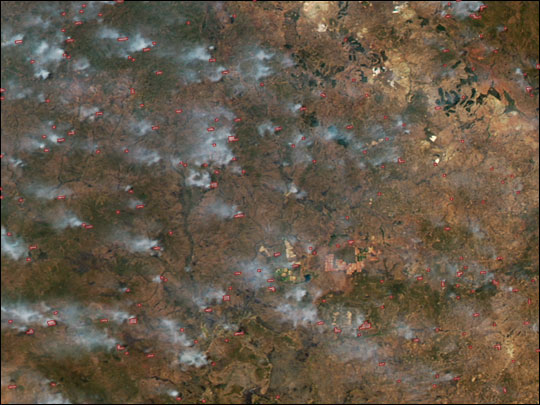

 | |||
Each August in southern Africa, literally thousands of people equipped with lighters or torches go out into the African savanna, a region dotted with villages and teaming with animals, and intentionally set the dry grasslands ablaze. The fires typically scorch an area the size of Montana, Wyoming, Idaho, and the Dakotas combined. Long plumes of smoke rise across the continent like hundreds of billowing smokestacks, and herds of animals are sent scurrying across open grassland. |
|||
 | |||
But unlike in the United States or Europe, where such burning would cause a national panic, it is a welcome occurrence in Africa during the late dry season. In fact, together with fires touched off by lightning, those started by people are a necessary part of the ecosystem on the savanna. Nutrients are released from the dead plants and returned to the soil, and the land is cleared for new grass to grow the following year. Ranch animals and wild animals from antelope to oxen to zebra depend on the restoration of the land and the renewed growth for food. At the same time the savannas are being cleared, seasonal cleanup is taking place in villages and cities of southern Africa. Locals set fire to small household plots and systematically clear roadside debris with fire. Charcoal for the coming year’s cooking needs is manufactured using a smoldering process. |
Smoke plumes dot the landscape of Zambia during the burning season (roughly September through April). Red outlines indicate the presence of fires. The smoke contributes to a buildup of ground-level ozone and other pollutants. (Image courtesy MODIS Land Rapid Response Team at NASA GSFC) | ||
Though all these activities are vital to life in Africa, they have a downside in the form of pollution. During fire season, a thick pall of smoke chokes the southern Africa skies for weeks each year. The smoke is laced with a number of gases such as nitrogen oxides, carbon monoxide, and hydrocarbons. These gases react with the intense heat and sunlight to form ozone. Unlike high-flying stratospheric ozone, ground level, tropospheric ozone can lead to a number of respiratory diseases, destroy lung tissue, and cause serious damage to crops. When present in the middle to upper troposphere, the molecules trap thermal radiation emanating from the Earth in the same way as carbon dioxide and other greenhouse gases do. In fact, up to 20 percent of the warming experienced by the Earth over the past 150 years is thought to be from ozone. |
Fires in Zambia are started both naturally by lightning and by humankind. People start fires to clear land for agriculture, produce charcoal, and to remove roadside debris. This crew is burning debris near Lusaka, Zambia. (Photograph courtesy Anne Thompson, NASA GSFC) | ||
In September 2000, Anne Thompson, a researcher at NASA’s Goddard Space Flight Center, flew to southern Africa to measure the ozone and help improve scientists’ abilities to extract low-level ozone measurements from instruments located in space. Not only did she find ozone levels to be higher than anticipated, but she also discovered further evidence of unusual wind currents above Africa that scatter the pollution well beyond Africa’s boundaries. The data used in this study are available in one or more of NASA's Earth Science Data Centers. |
The widespread fires in Africa also produce other pollutants, like carbon monoxide, in addition to ozone. This map shows carbon monoxide concentrations measured by the Measurements of Pollution in the Troposphere (MOPITT) instrument, over central Africa on May 17, 2003. (Image courtesy Jesse Allen, NASA Earth Observatory, based upon data provided by NCAR and University of Toronto MOPITT teams) | ||